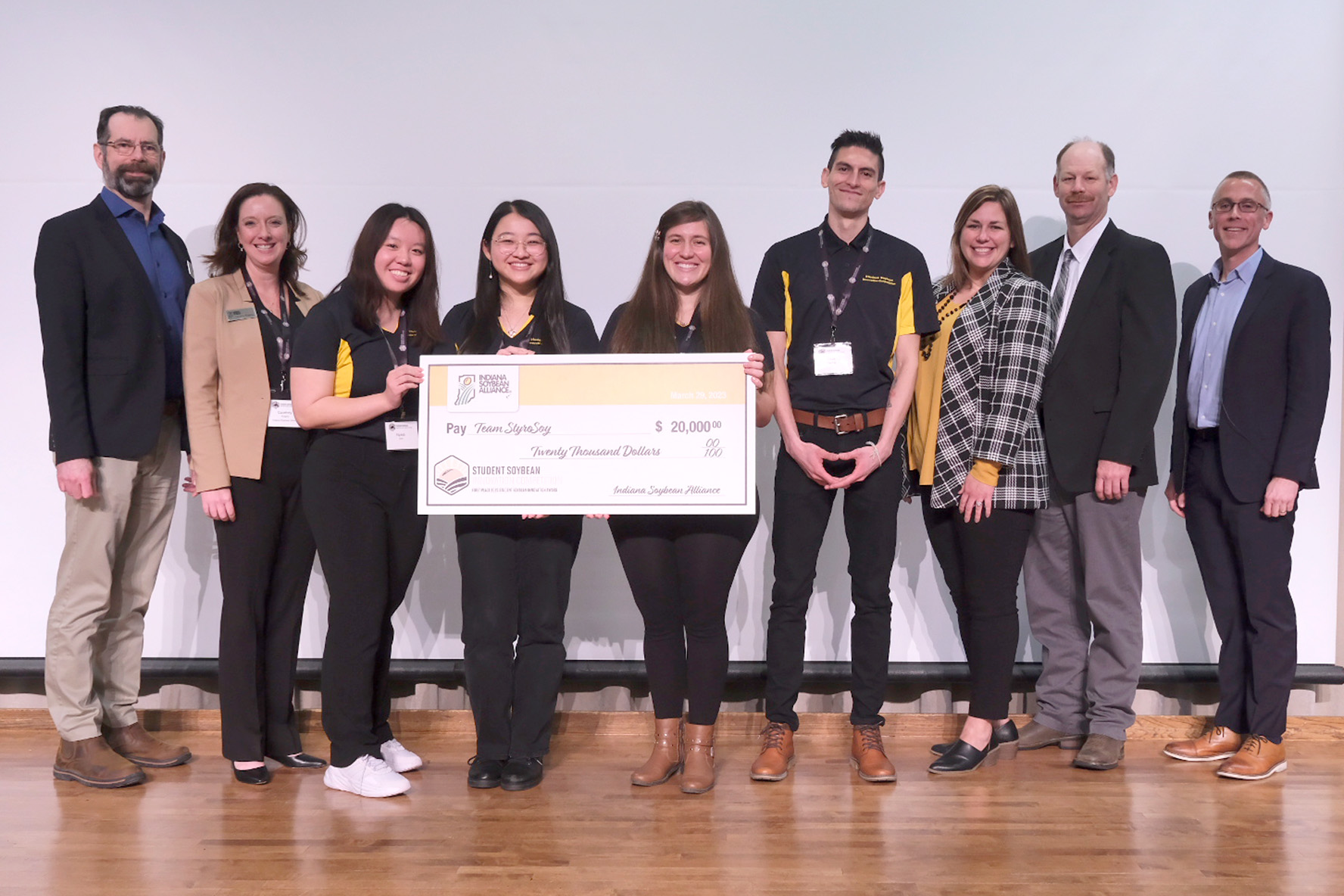Soybeans are nothing new to Alison Dunbar. The biological engineering sophomore grew up in Chicago’s southwest suburbs where a soybean field ran through her backyard.
“I was raised around agriculture, so I had a good idea of what soybeans were used for. Still, it was shocking to learn just how versatile they are. How many products they can be in.”
Statements like these are common at the Student Soybean Innovation Competition, which recently held its 29th annual contest.
Sponsored by the Indiana Soybean Alliance (ISA) and Purdue University, the competition challenges entrants to address market needs by developing novel applications for soybeans.
“There’s potential every year for another product to go to commercialization,” said Micky Creech, program manager of the Student Soybean Innovation Competition. “Innovations like soy crayons and soy candles came from the competition. With creations like those, farmers’ checkoff dollars help develop an increased demand for soybeans.”
One rule of the competition is that students' innovations cannot be on the market already. Competitors also cannot use ideas from previous teams. Even with 29 years of ideas already explored, Creech said the competition continues to grow thanks to the students’ creativity and soybeans’ versatility.
This year, 12 teams formed by 34 Purdue students made it through the elimination round to final judging. Over six months, they took their ideas through patent research, market analysis, refinements and marketing. Last week, the teams shared their innovations at a trade show and award ceremony on campus with over 300 attendees. There, they learned the results of the previous week's judging.
Dunbar’s team created SOYscara, a soy-based mascara, for the competition. Conwy Zheng, another member of Team SOYscara, explained, “our product looked to replace harmful PFAS materials in waterproof mascara. It includes clean ingredients that are beneficial to skin and is easily removable.”
Like Dunbar, Zheng was impressed by the versatility of soybeans. “Before the competition, I only thought of soybeans as food products,” he explained.
Zheng was also impressed by his team. “It was unbelievable what we accomplished, how we were able to go from an idea to a real product so quickly.”
Their team finished third, earning $5,000.
 Guests visit the Team SoySafe booth at the Student Soybean Innovation Competition to learn more about their soy-based drywall replacement product.
Guests visit the Team SoySafe booth at the Student Soybean Innovation Competition to learn more about their soy-based drywall replacement product. Second place went to Team SoySafe for their development of a soy-based drywall replacement, said to be cheaper and easier to produce than common drywall products.
First place, and the $20,000 grand prize, were earned by Team StyroSoy. The biodegradable, compostable, non-toxic, soy-based foam was developed as a potential alternative to Styrofoam. Team StyroSoy also received the most votes from attendees for the People’s Choice Award, earning an additional $500.
StyroSoy co-creator Alyssa Choi, a sophomore studying biological engineering, said winning was about more than money. “In the future, I want to do R&D in food,” said Choi. “This experience was perfect for that. It has helped me gain a wide range of skills such as research, lab work, marketing and public speaking that I will definitely continue to use in the future.”
Choi’s teammate, Amy Tang, is similarly considering a career in research and development thanks to the competition. “This was my first experience in a lab outside class. It showed me perseverance is key and that being an undergraduate does not stop me from achieving amazing outcomes. It helped me realize that I enjoy being in a lab and doing experiments.”
 Team StyroSoy received first place along with the People’s Choice Award.
Team StyroSoy received first place along with the People’s Choice Award. For many teams, the ceremony marked the finish line, but for those that want to continue, opportunities are available.
“In the past, students were excited about their product and wanted to know what their next step was. We did not have a great answer back then,” Creech explained. “A few years ago, we worked with the Purdue Foundry and started the ASPIRE Internship.”
The paid internship, offered to competition participants, focuses on entrepreneurship and direct marketing. After the internship, students can pitch for Ag-Celerator funding.
Alternatively, students are welcome to enter the competition every year if they develop new products. This year’s runner-up, Team SoySafe, finished second last year as well. Team member Charlie Sebright, an agricultural engineering student, has already started planning with his team for 2024.
“This competition has left us feeling inspired and motivated to continue improving,” said Sebright. “We are confident that the skills we gained will serve us well in next year’s competition. The key to this competition is your idea and thanks to our first two years, we now know what a winning idea looks like.”
And while just three of the 12 teams left the award ceremony with an oversized check, Dunbar explained that everyone walked away with valuable experience.
“I would recommend the competition to everyone,” said Dunbar. “Even if you don’t win the money, you’re still getting a huge resume boost. You’ll have something really impressive you can talk to future employers about. That’s something I saw the benefit of. I am proud and grateful.”





